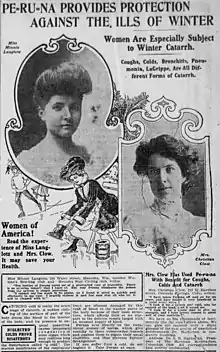Peruna (patent medicine)
Peruna was a well-known patent medicine sold from the late 19th to mid 20th century. The mascot of Southern Methodist University was named after the product. It was patented by Samuel Brubaker Hartman, and endorsed by hundreds of politicians. Hartman began selling the product on July 29, 1885, and advertised it as curing catarrh.[1] At its peak, Hartman was earning $100,000 a day from Peruna sales.[2] The drug was reportedly so popular that babies were named after it.[3] Peruna once released an ad with 50 United States Congressmen endorsing the product.[3]
 An advertisement for Peruna. The women shown as endorsing Peruna may not have existed. | |
| Type | Patent medicine |
|---|---|
| Inventor | Samuel Brubaker Hartman |
| Inception | July 29, 1885 |
| Manufacturer | Peruna Company |
| Available | No |
In a series of 11 articles Samuel Hopkins Adams wrote for Collier's in 1905, "The Great American Fraud", Adams exposed many of the false claims made about patent medicines, pointing out that in some cases these medicines were damaging the health of the people using them. On October 20, 1906, Adams published an article in Collier's, claiming that Peruna and other such patent-medicines were frauds, for instance alleging that Peruna was 28% alcohol. The series had a huge impact and led to the passage of the Pure Food and Drug Act of 1906. In 1911, the Supreme Court ruled that the prohibition of falsifications referred only to the ingredients of the medicine.[1][4][5]
This meant that companies were again free to make false claims about their products. Adams returned to the attack, and in another series of articles in Collier's Weekly, Adams exposed the misleading advertising that companies were using to sell their products. Linking his knowledge of newspapers with patent medicines, he wrote The Clarion (1914), which was critical of newspaper advertising practices and led to a series of consumer-protection articles in the New York Tribune.[1][4][5] When Prohibition came into effect, Americans began using Peruna and other similar products as a way to get drink amounts of alcohol. Peruna had stopped being sold by the mid 1940s.[6]
References
- "Catarrh Remedy: Peruna Scandal". Library of Congress. Retrieved 2019-05-11.
- Hunter, Bob (2012-10-19). A Historical Guidebook to Old Columbus: Finding the Past in the Present in Ohio’s Capital City. Ohio University Press. p. 198. ISBN 9780821444368.
- Young, James Harvey (2015) [1972]. The Toadstool Millionaires. Princeton University Press. pp. 187, 218. ISBN 978-1-4008-6900-8. OCLC 599159278 – via Project MUSE.
- Kennedy, Samuel V. "Adams, Samuel Hopkins" (Kennedy); American National Biography Online Feb. 2000.
- Kennedy, Samuel V. (1999). Samuel Hopkins Adams and the Business of Writing. Syracuse University Press. p. 46. ISBN 9780815627999.
- "SMU's mascot's namesake was also known for its 'kick'". Dallas News. 2018-10-08. Retrieved 2019-05-11.